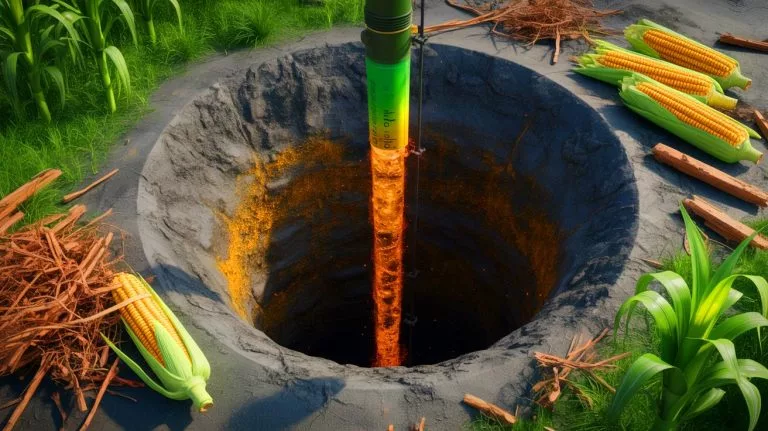| IN A NUTSHELL |
|
In recent years, researchers have been exploring innovative methods to address environmental challenges, and a new study from Iowa State University has unveiled a promising solution. By transforming plant waste into a liquid known as bio-oil, scientists have discovered a dual-purpose approach that not only sequesters carbon but also addresses the issue of abandoned oil wells. This breakthrough could represent a significant step forward in the fight against climate change, offering a cost-effective and sustainable method for carbon removal. With a proposed network of mobile bio-oil production facilities, the potential for widespread implementation is on the horizon.
Innovative Carbon Sequestration
The Iowa State University study focuses on utilizing bio-oil for carbon sequestration by injecting it into abandoned oil wells. This approach leverages plant waste, such as corn stalks and forest debris, as a resource for creating bio-oil. Unlike conventional carbon capture methods, which often require large, centralized facilities, this technique is decentralized and cost-effective. Researchers aim to convert plant-based waste into a dense, carbon-rich liquid through a process called fast pyrolysis, which involves heating organic matter to high temperatures in an oxygen-free environment. The resulting bio-oil is then used to plug abandoned wells, effectively storing carbon underground.
Abandoned oil wells pose significant environmental risks, including methane leaks and water contamination. The U.S. is estimated to have between 300,000 and 800,000 undocumented orphaned wells, and capping these wells can be costly, often exceeding $1 million each. By integrating bio-oil into this process, researchers provide a more sustainable and economically viable solution. The study suggests that bio-oil sequestration could compete with other carbon removal technologies on cost, estimated at approximately $152 per ton, with potential reductions in the future.
Fast Pyrolysis Technique
The fast pyrolysis technique central to this study is a crucial component of the proposed carbon sequestration method. By rapidly heating plant waste to temperatures over 1,000°F without oxygen, the process converts the waste into bio-oil, which is rich in carbon. This method not only captures carbon from the air but also creates a valuable resource for sealing oil wells. The mobile production units envisioned by researchers would enable localized processing, reducing the need for extensive transportation and infrastructure.
By addressing both carbon sequestration and abandoned well capping, this approach offers a comprehensive solution to two pressing environmental issues. The decentralized nature of the method allows for flexibility and scalability, making it an attractive option for various regions across the United States. Additionally, by utilizing underutilized resources like plant waste, the method provides new economic opportunities for agricultural and forestry sectors.
Network of Mobile Units
The proposed network of 200 mobile bio-oil production facilities is designed to operate near biomass sources, such as farm fields and forests. Each unit would process roughly 10 tons of feedstock daily, with an initial construction cost of $1.3 million per unit. The study predicts that bio-oil would need to be sold for at least $175 per ton to be economically viable. This distributed approach contrasts with centralized carbon capture facilities and offers a lower upfront investment.
The cost-effectiveness of the method varies depending on the feedstock used. Wood-based materials are identified as the most economical option, costing approximately $100 per ton of carbon removal. This flexibility allows for adaptation to local resources and conditions, enhancing the feasibility of widespread implementation. The study, commissioned by Charm Industrial, highlights the potential for bio-oil sequestration to deliver durable carbon removal solutions while also providing economic value to rural economies.
Potential Impact and Future Considerations
The Iowa State University study underscores the viability of bio-oil as a competitive alternative to conventional carbon capture methods like direct air capture. By addressing both carbon sequestration and abandoned well capping, the bio-oil system presents a multifaceted solution to environmental challenges. The research, published in the journal Energy Conversion and Management, provides a comprehensive analysis of the technology’s potential for large-scale application.
As the world seeks effective strategies to combat climate change, the proposed bio-oil network offers a promising avenue for progress. By leveraging existing resources and infrastructure, this approach aligns with global efforts to reduce carbon emissions and mitigate environmental risks. As researchers continue to refine and scale this technology, the question remains: How will policymakers and industry leaders respond to the potential of bio-oil as a cornerstone of sustainable environmental management?
Did you like it? 4.3/5 (26)







Wow, this is a brilliant idea! 🌱 How soon can we expect to see this implemented?
Wow, this is amazing! 🌽 Who would have thought corn stalks could help save the planet?
This sounds promising, but have the long-term effects of bio-oil on the environment been studied?
Are there any environmental downsides to using bio-oil for sealing wells? 🤔
I’m skeptical. $152 per ton doesn’t seem very cost-effective compared to other methods. 🤔
Great initiative! Thanks to the scientists for their hard work. 👏
This sounds like a game-changer! How soon can we expect these mobile units to be operational?
How does this compare with traditional methods in terms of scalability?
I love the idea of turning waste into something beneficial. Kudos to the researchers! 👏
Can this technique be applied to other types of plant waste or just corn stalks?
Why haven’t we thought of this sooner? It seems so logical!
152 tons per million dollars doesn’t sound like much, is it really effective on a large scale?
Is the bio-oil safe for the soil and local ecosystem once injected?
How do they ensure that the abandoned wells are completely sealed?
Sounds too good to be true. What’s the catch?
Is there any government support or funding for this project?
How do they plan to handle regions with less agricultural waste?
Are there any potential risks involving the transport of bio-oil? 🚚
This could really boost rural economies! Great thinking. 🌾
What is the carbon footprint of producing and transporting the bio-oil?
I’m curious about the energy consumption of the fast pyrolysis process. Is it efficient?
Can this technology be adapted for use in other countries?
Are there any competing technologies that offer similar benefits?
Love the idea of mobile units! Very innovative. 🚀
Have they considered the impact on local wildlife when sealing the wells?
What happens to the bio-oil if it’s not used to seal wells?
Could this technology replace other forms of carbon capture in the future?
How will they ensure that the units remain cost-effective over time?
Is there a way to involve local communities in the process?
The article doesn’t mention potential drawbacks. Are there any?
How much of a dent can this make in overall carbon emissions?
Could this technology be integrated with other renewable energy systems?
What kind of jobs will this create in rural areas?
Do they have any pilot projects running to test the feasibility?
How do they plan to deal with any potential leaks from the wells?
I’m impressed by the decentralized approach! 👏
Can this method be scaled up to address more significant environmental challenges?
Have the social and economic impacts been assessed for local communities?
This is an exciting development! Can’t wait to see it in action. 🌎